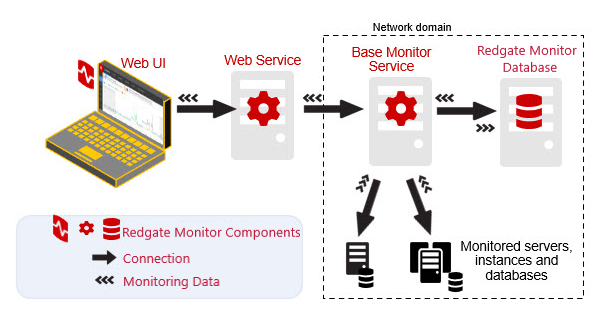Planning for Redgate Monitor
Published 28 March 2024
Redgate Monitor is made of two main components, a Base Monitor and a website. The Base Monitor is responsible for gathering, storing, and alerting on data. It stores and manages the data in the Redgate Monitor database. The website displays all this data in a user-friendly format accessible from a web browser. Users of the website provide login details to view monitoring data, as well as to administer the monitoring service. Redgate Monitor doesn't require the installation of an Agent service on each monitored server. Instead, it uses industry-standard systems for accessing remote computers (via WMI for Windows, or SSH for Linux) and it communicates with database instances using their normal connection protocols (e.g. with the SQL Server service using T-SQL via TDS). The WMI connection can either use DCOM or WinRM for transport.
A basic Redgate Monitor installation will look something like this:
Therefore, when planning to install Redgate Monitor you will need to set up these three logical components of the monitoring service, as follows:
- The Base Monitor service (also called the Monitoring service) – a Windows or Linux service that continuously monitors the database instances, wherever they are located, collecting, storing and transmitting the monitoring data (metrics and alerts).
- Redgate Monitor database (also called the Data Repository) – a SQL Server or PostgreSQL with TimescaleDB database used by the Base Monitor for storing and managing the sampled metric and alert data, as well as Redgate Monitor configuration settings. It is called RedGateMonitor by default.
- Web server – to run the Web server service, host the Redgate Monitor web console and provide an interface with the Redgate Monitor PowerShell scripting API.
- Web UI – presents the metric and alert data to users, in the form of various graphs, projections, tables, reports and charts. Users can view monitoring data, manage monitored servers, configure Redgate Monitor, and so on.
- Web Server service – connects over secure RPC to its Base Monitor to request the monitoring data, and to authenticate users. The communication between the monitoring service and the Web Server is encrypted with a self-signed certificate. In response to these requests, the Base Monitor retrieves and interprets the stored monitoring data, and sends over the data streams required to populate and refresh the web interface.
For more detailed planning of the Redgate Monitor installation, see Planning the Redgate Monitor infrastructure and installation.





